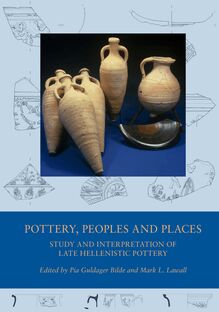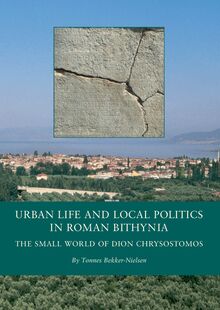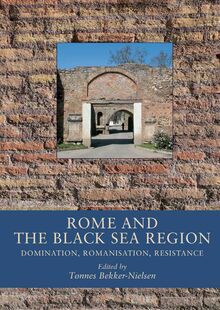-
 Univers
Univers
-
 Ebooks
Ebooks
-
 Livres audio
Livres audio
-
 Presse
Presse
-
 Podcasts
Podcasts
-
 BD
BD
-
 Documents
Documents
-
- Cours
- Révisions
- Ressources pédagogiques
- Sciences de l’éducation
- Manuels scolaires
- Langues
- Travaux de classe
- Annales de BEP
- Etudes supérieures
- Maternelle et primaire
- Fiches de lecture
- Orientation scolaire
- Méthodologie
- Corrigés de devoir
- Annales d’examens et concours
- Annales du bac
- Annales du brevet
- Rapports de stage
La lecture à portée de main
420 pages
English
Découvre YouScribe en t'inscrivant gratuitement
Je m'inscrisDécouvre YouScribe en t'inscrivant gratuitement
Je m'inscris
Obtenez un accès à la bibliothèque pour le consulter en ligne
En savoir plus
En savoir plus
420 pages
English
Obtenez un accès à la bibliothèque pour le consulter en ligne
En savoir plus
En savoir plus

Description
In late Antiquity, archaeology demonstrates lively and far-flung exchange along the river Dniester, through current Poland to the Baltic. By the 11th century the former Barbaricum had been transformed into a string of Christian kingdoms and principalities, whose parallel histories are as conspicious as their differences. From the legendary (if possible real) migrations of the Goths in Antiquity to the Varangian guard at the imperial court of Byzantium in the late Viking Age, trans-cultural interaction complemented important historical development. This book is about aspects of the changing interactions from late Antiquity to the High Middle Ages, from Goths to Varangians, and from the Baltic to the Black Sea. The history and archaeology of these connections have been poorly exposed and investigated in modern times. The papers presented in this volume are a selection of those presented during a series of four meetings organised 2007-2009 by the "Varangian Network", an interdisciplinary network for archaeological and historical research on relations between the Baltic and the Black Sea from late Antiquity to the medieval period.
Sujets
Informations
| Publié par | Aarhus University Press |
| Date de parution | 13 août 2013 |
| Nombre de lectures | 2 |
| EAN13 | 9788771244250 |
| Langue | English |
| Poids de l'ouvrage | 49 Mo |
Informations légales : prix de location à la page 0,2550€. Cette information est donnée uniquement à titre indicatif conformément à la législation en vigueur.
Extrait
FROM GOTHS TO VARANGIANS COMMUNICATION AND CULTURAL EXCHANGE BETWEEN THE BALTIC AND THE BLACK SEA
Edited byLine Bjerg, John H. Lind & Søren M. Sindbæk
Dedicated to the memory of
Pia Guldager Bilde (Born 11 February 1961 †10 January 2013)
Director of the Danish National Research Foundation’s Centre for Black Sea Studies
FROM GOTHS
TO VARANGIANS
This page is protected by copyright and may not be redistributed
BLACK SEA STUDIES
15
THE DANISH NATIONAL RESEARCH FOUNDATION’S CENTRE FOR BLACK SEA STUDIES
Comprising the proceedings of the 30th symposium organized by the Centre for Medieval Studies, University of Southern Denmark, November 2009, in collaboration with the Varangian network.
This page is protected by copyright and may not be redistributed
FROM GOTHS TO VARANGIANS
COMMUNICATIONANDCULTURALEXCHANGEBETWEENTHEBALTICANDTHEBLACKSEA
Edited by Line Bjerg, John H. Lind & Søren M. Sindbæk
AARHUS UNIVERSITY PRESS
This page is protected by copyright and may not be redistributed
FROM GOTHS TO VARANGIANS
© Aarhus University Press and the authors 2013 Cover design by Jørgen Sparre Cover photos: reliquary cross and glass decorations from Gnezdovo
E-book production: Narayana Press
ISBN 978 87 7124 425 0
AARHUS UNIVERSITY PRESS Langelandsgade 177 DK-8200 Aarhus N
White Cross Mills Lancaster LA1 4XS England
70 Enterprise Drive Bristol, CT 06010 USA
www.unipress.dk
The publication of this volume has been made possible by generous grants from Dronning Margrethes Arkæologiske Fond, Elisabeth Munksgaards Fond, Gieses Fond, Japetus Steenstrups Fond and Aarhus University’s Research Foundation
Danish National Research Foundation’s Centre for Black Sea Studies University of Aarhus DK-8000 Aarhus C www.pontos.dk
Weblinks were active when the book was printed. They may no longer be active
This page is protected by copyright and may not be redistributed
Contents
Line Bjerg, John H. Lind & Søren M. Sindbæk Introduction
Leo S. Klejn The Russian controversy over the Varangians
Johan Callmer At the watershed between the Baltic and the Pontic before Gnezdovo
Helle Winge Horsnæs Networking in north-eastern Barbaricum: a study of gold imitations of Roman coins
Line Bjerg The Herulians are coming!
Fedir Androshchuk Byzantium and the Scandinavian world in the 9th-10th century: material evidence of contacts
Margarita Gleba Chasing gold threads:auratae vestesfrom Hellenistic rulers to Varangian guards
Natalia Eniosova & Tamara Puškina Finds of Byzantine origin from the early urban centre Gnezdovo in the light of the contacts between Rus’ and Constantinople (10th – early 11th centuries AD)
Volodymyr Kovalenko Scandinavians in the East of Europe: in search of glory or a new motherland?
This page is protected by copyright and may not be redistributed
7
27
39
87
131
147
193
213
257
6
Contents
Ole Crumlin-Pedersen(†) Viking warriors and the Byzantine Empire: was there a transfer of nautical technology?
Elena Melnikova Mental maps of the Old Russian chronicle-writer of the early twelfth century
John H. Lind Darkness in the East? Scandinavian scholars on the question of Eastern influence in Scandinavia during the Viking Age and Early Middle Ages
295
317
341
Ildar H. Garipzanov The journey of St Clement’s cult from the Black Sea to the Baltic Region369
Ulla Haastrup & John H. Lind Royal family connections and the Byzantine impact on Danish Romanesque church frescos. Queen Margareth Fredkulla and her nieces
Index
C o n t e n t s I n d e x This page is protected by copyright and may not be redistributed
381
413
Introduction
Line Bjerg, John H. Lind & Søren M. Sindbæk
From Goths to Varangians – from the Baltic to the Black Sea
Seen from the Baltic, the Black Sea region can appear a distant and exotic realm; yet in terms of geography the two seas are not that far apart. The dis-tance from Gotland to Crimea is very nearly the same as that from Constanti-nople to Sardinia, upon which the Byzantine capital often depended for grain. It should be no surprise, then, that for much of the Middle Ages archaeology and history trace close relations along the lands and rivers, which bridged the two great inland seas of Europe. In late Antiquity, archaeology demonstrates lively and far-flung exchange along the river Dniester, through current Poland to the Baltic. The earliest runic script emerged within this zone of interaction, examples being found 1 from Moldavia to Scandinavia. Magnificent jewellery, like the East Roman gold filigree ornaments found in the Brangstrup hoard or the nearby Årslev 2 Grave in Fyn, almost certainly travelled north from South-East Europe. So did numerous glass vessels found in graves in Scandinavia and the Baltic Sea 3 area, along with coins and other imports. While some of these items were produced in the eastern parts of the Roman Empire, others were from the areas of the current Ukraine, Moldova and Romania, where Gothic tribes es-4 tablished their kingdom in the second century AD. In later centuries Gothic princes claimed to have descended from Scandinavian dynasties in the north. Even if these claims are legendary, the myth of origin may have given Gothic aristocracy an incentive to maintain exchanges with princes in what they con-sidered an ancient homeland, traversing much of what would be referred to from a Roman perspective asBarbaricum. By the 11th century the formerBarbaricumhad been transformed into a string of Christian kingdoms and principalities, whose parallel histories are as conspicuous as their differences. Through the Viking Age they had expe-rienced powerful cultural and economic integration, thanks in part to the emergence of a new continental by-pass, the Dnieper route, or “The Road from Greeks to Varangians”, as it is called in an early 12th-century Russian chronicle. Along this route a string of emporia emerged, from Birka in the Baltic to Staraja Ladoga and Rjurikovo Gorodišče in north-west Russia, via Gnezdovo to Kiev in the Ukraine. The archaeology of these centres is marked by evidence of close cultural encounters, including Islamic and Byzantine imports, and sometimes the use and manufacture of Scandinavian-style or-
C o n t e n t s I n d e x This page is protected by copyright and may not be redistributed
8
Line Bjerg, John H. Lind & Søren M. Sindbæk
5 naments. Their significance as nodes in a common commercial and cultural network is brought out by a shared system of exchange based on the use of Arabic coins and other forms of silver as bullion in a “weight-money” economy, and by merchant-warriors, whose furnished chamber graves can 6 be found in Hedeby, Birka, Pskov, Šestovica, Gnezdovo or Kiev. Presumably these were the Rus’ – travelling merchant-warriors from the north – of con-temporary Byzantine and Arab written sources. Later, as the word Rus’ came to refer to a fixed geographical area, travellers from the north became known 7 as Varangians. They formed the stock of the Byzantine emperor’s famous Varangian guard, and counted celebrities such as the later Norwegian king, Haraldr Hardrádi – who, after winning the Norwegian throne, launched a 8 large mintage modeled on Byzantine designs. He and other travelers carried more than treasure back. Many Scandinavians must have made their first ac-quaintance with Christianity while travelling in the East; and Scandinavian church art demonstrate a solid stylistic influence from Byzantium and Russia, 9 as seen in 12th century frescoes in Danish and especially Gotland churches. From the legendary (if possibly real) migrations of the Goths in Antiquity to the Varangian guard at the imperial court of Byzantium in the late Viking Age, trans-cultural interaction complemented important historical develop-ments. Why were the sort of contacts exemplified by Goths and Varangians brought into existence? If they were a ubiquitous feature of human societies, the question might not need asking. Yet at other times in history long-distance communication is less prominent. Between the Goths and Varangians lies a period of several centuries when interaction between the Baltic and the Black 10 Sea, when not entirely absent, is much more difficult to trace. We may ask indeed why people in early societies, who were challenged to maintain their subsistence and to cope with local and regional conflicts in a non-state order, should invest time and resources in maintaining bonds with people, who were too distant to yield any meaningful support on a day-to-day basis. What made such links significant? This book is about aspects of the changing interactions from late Antiquity to the High Middle Ages, from Goths to Varangians, and from the Baltic to the Black Sea. Goths and Varangians frame an episode fromc. 300-1200 when the East Mediterranean and the Near East was a power house of western Eurasia. From the decline of the Western Roman Empire to the crippling of Byzantium during the Fourth Crusade, the roads to the Black Sea were a focus of atten-tion for societies in the north. The history and archaeology of these connections have been poorly ex-posed and investigated in modern times. Problems of language and a polariza-tion in the research traditions have combined with a troubled modern, politi-cal history to form a dead angle in the historical culture of Europe, neglected variously as irrelevant, inconvenient or simply incomprehensible.
C o n t e n t s I n d e x This page is protected by copyright and may not be redistributed
-
 Univers
Univers
-
 Ebooks
Ebooks
-
 Livres audio
Livres audio
-
 Presse
Presse
-
 Podcasts
Podcasts
-
 BD
BD
-
 Documents
Documents
-
Jeunesse
-
Littérature
-
Ressources professionnelles
-
Santé et bien-être
-
Savoirs
-
Education
-
Loisirs et hobbies
-
Art, musique et cinéma
-
Actualité et débat de société
-
Jeunesse
-
Littérature
-
Ressources professionnelles
-
Santé et bien-être
-
Savoirs
-
Education
-
Loisirs et hobbies
-
Art, musique et cinéma
-
Actualité et débat de société
-
Actualités
-
Lifestyle
-
Presse jeunesse
-
Presse professionnelle
-
Pratique
-
Presse sportive
-
Presse internationale
-
Culture & Médias
-
Action et Aventures
-
Science-fiction et Fantasy
-
Société
-
Jeunesse
-
Littérature
-
Ressources professionnelles
-
Santé et bien-être
-
Savoirs
-
Education
-
Loisirs et hobbies
-
Art, musique et cinéma
-
Actualité et débat de société
- Cours
- Révisions
- Ressources pédagogiques
- Sciences de l’éducation
- Manuels scolaires
- Langues
- Travaux de classe
- Annales de BEP
- Etudes supérieures
- Maternelle et primaire
- Fiches de lecture
- Orientation scolaire
- Méthodologie
- Corrigés de devoir
- Annales d’examens et concours
- Annales du bac
- Annales du brevet
- Rapports de stage
Signaler un problème
YouScribe
Le catalogue
Le service
© 2010-2024 YouScribe









